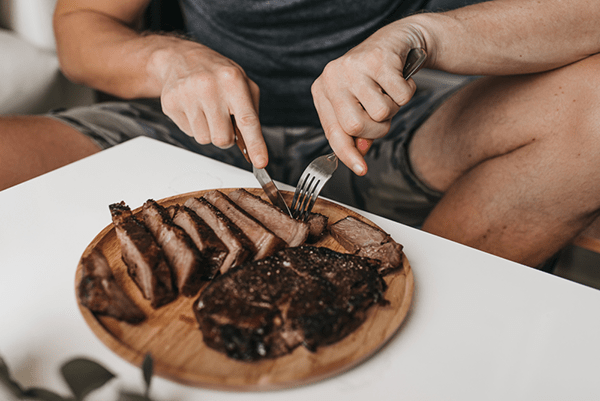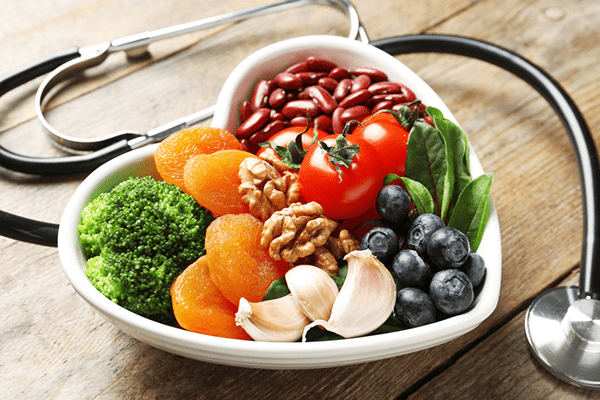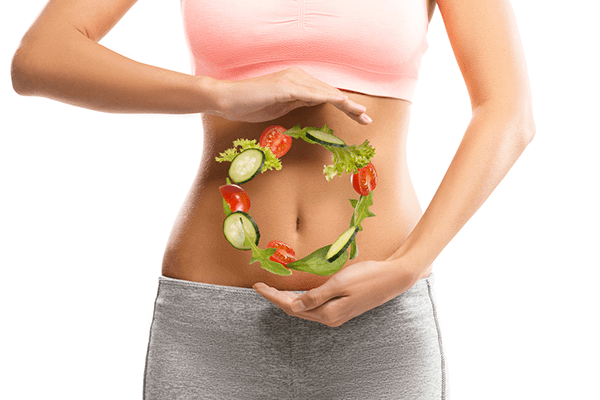Are high-fiber foods going to be the new protein bars?
Many are predicting an impending fiber takeover of the nutrition world, and with good reason: The average American gets barely half of the recommended daily fiber intake!
The reason that needs to change? Fiber has been shown to naturally support so many areas of your overall health. From weight management and heart health to better digestive health, the amount of fiber you eat can be just as important as your macros for protein and healthy fats.
We’ve got all the most important fiber info for you below, including its health benefits and 25 of the best high-fiber foods to add to your diet starting today.
What Is Dietary Fiber?
Dietary fiber is the edible part of plants that your body can’t digest. Instead of getting broken down in your body, fiber just passes through your system intact. Vegetables, fruits, and foods with whole grains are all great sources of dietary fiber. (1).
There are two types of fiber: soluble and insoluble fiber. Your body needs both types of fiber for optimal digestive health because they work differently.
Soluble fiber sources are slow-digesting. As soluble fiber moves through your system, it dissolves in water to becomes gel-like. In this gel-like form, the fiber can pass through your digestive tract easily (3). Soluble fiber can be found in nuts, seeds, oats, beans, lentils, and certain fruits and veggies.
Insoluble fiber does not get digested and instead works to bulk up your stool. This speeds up how quickly food moves through your digestive tract. Whole grains such as bulgur, vegetables like green peas, and wheat bran are great sources for insoluble fiber (3).
A combination of both soluble and insoluble fiber keeps your digestive system in good working order and also keeps it moving regularly, which is useful for combating and avoiding constipation (2).
How Much Fiber Do You Need a Day?
For adults between the ages of 19-50, women are recommended to consume 25 grams of fiber per day while men are recommended to consume 38 grams a day. The current recommendations for daily fiber intake are 25 grams for women and 38 grams for men (if you’re between the ages of 19-50) (7).
However, current estimates show many Americans are only getting about 15 grams of fiber each day.
Why Aren’t Most People Getting Enough Fiber?
Despite there being a lot of high fiber foods, there are several reasons why most people don’t get enough fiber everyday:
First, many people don’t eat enough fruits and veggies even though these are fiber powerhouses. Instead, they turn to high-carb foods like pizza, white bread, and white rice. While these foods may fill you up, they don’t deliver the same health benefits of foods that are high in fiber. Switching to whole-grain bread or brown rice will replace some of those carbs with beneficial fiber content (as will adding more fruits and veggies to your meals).
Another problem is the popularity of low-carb, high-fat, and high-protein diets. On these, people often eliminate many fruits, veggies, and whole grains from their diets, due to a fear of eating any carbs (1). But if you’re not careful, this decrease also ushers in a drastic cut in dietary fiber. (This is also one reason many people on low-carb diets experience constipation!)
People on these types of diets must take extra steps to ensure the carbs they eat contain higher amounts of fiber. The good news? The more fiber a food contains, the lower the net carbs. So you can easily fix your low fiber intake without adding too many carbs to your diet.

Why Is Fiber Important To Overall Health?
Fiber has been shown to help support against many of the most pressing health conditions faced by people all over the world. Many of those conditions start with trouble maintaining a healthy weight.
Fiber helps add bulk to your diet so you feel satisfied sooner and eat less (2). That’s why researchers believe a high-fiber diet may help with healthy weight management, supported blood sugar regulation and supported heart health (4).
Fiber can also support your gut health and has been shown to help various gut-related conditions, among other perks (2).
Health Benefits of Fiber
The research and scientific evidence show a diet packed with high-fiber foods may be able to:
1. Support a Healthy Heart
One of the biggest benefits of getting enough fiber is that it supports healthy cholesterol and blood pressure levels (4). This is because fiber can help regulate levels of low-density lipoprotein (LDL), also known as “bad” cholesterol levels, without touching the “good” cholesterol known as high-density lipoprotein (HDL).
Additional research is needed to prove these findings further, but the results seem promising so far.

2. Support Healthy Blood Sugar Regulation
Another benefit of fiber is that it supports healthy blood sugar levels. In a study conducted on 75,000 people over 14 years, scientists discovered people consuming at least 15g of fiber per day helped to support healthy blood sugar regulation (4).
Additionally, researchers from a review of 16 meta-analyses found that the cereal fiber found in brown rice, barley, and seeds provides the greatest blood sugar regulation benefits (5).
3. Support Digestion
Since insoluble fiber adds weight to your stools and soluble fiber makes them softer and easier to pass, fiber can fight constipation and ensure your digestion moves along as it should — not too fast and not too slow (4).
It also decreases the transit time so you can eliminate waste regularly instead of every few days (4).
Research shows that wheat bran, which is packed with insoluble fiber, is the “gold standard” when it comes to increasing stool size (4). This can also reduce your risk of various unwanted health conditions (6).

4. Help Increase Satiety
One of the great benefits of fiber is that it may fill you up and suppress your desire to snack on extra calories (5).
After reviewing over 50 studies on fiber and weight control, scientists concluded that people who increased their fiber intake by 14 grams per day were able to decrease their calories naturally, which led to an average weight loss of 4.4 pounds in four months (5).

Three Simple Principles to Get More Fiber In Your Diet
Women should get 25g of fiber per day; men should aim for 38g per day (7). What’s the best way to hit those targets.
Good sources of fiber fall into three specific categories: fruits, vegetables, and whole grains. As long as you weave a few foods from each category into your meals and healthy snacks, you’ll be a step closer to meeting your fiber goals with each bite. Before we share examples of high-fiber foods, here are three principles to keep in mind throughout your days:
1. Eat your veggies first
Each meal should have a portion of veggies and while they may not always be as enjoyable as the steak next to them, the fiber can help support your digestion — especially if it’s a big meal! Start with the veggies.
2. Make fruits your snack of choice
While small, many fruits are packed with fiber and because fiber helps you feel full, snacking on fruits them will also help you snack less. In fruits like apples, most of the fiber is in the skin, so leave the skin on!
3. Stick to whole grains
When you have an option to have whole grains, choose the whole grains. Refined grains have been stripped of vitamins and fiber and have little nutritional value. By sticking with whole grains, you’ll choose the healthier option and feel fuller for longer.
25 Best High-Fiber Foods
In addition to the three principles above, here’s a list of high-fiber foods to add to your diet and the corresponding amount of fiber in each, according to the U.S. Department of Agriculture (7)(10):
- Avocados – One avocado (200g) contains about 13.5g of fiber
- Pears – A medium-sized pear (178g) contains about 5g of fiber
- Apples – A medium-sized apple (182g) contains about 4g of fiber
- Bananas – A medium-sized banana (118g) contains about 3g of fiber
- Artichokes – 100g of artichoke contains about 1.6g of fiber
- Asparagus – A cup of asparagus contains about 3g of fiber
- Cauliflower – A cup of cauliflower contains about 3g of fiber
- Brussels sprouts – A cup of cooked brussels sprouts contains about 2.5g of fiber
- Broccoli – A cup of broccoli contains about 2g of fiber
- Spinach – A bunch of spinach (340g) contains about 7.5g of fiber
- String beans – A cup of string beans contains about 2.5g of fiber
- Peas – A cup of peas contains about 8g of fiber
- Edamame – A cup of shelled edamame contains about 8g of fiber
- Brown rice – A cup of brown rice contains about 2.5g of fiber
- Oatmeal – A cup of cooked oatmeal contains about 2g of fiber
- Quinoa – A cup of cooked quinoa contains about 5g of fiber
- Potatoes – A medium potato (167g) contains about 3g of fiber
- Sweet potatoes – A medium sweet potato (119g) contains about 3.5g of fiber
- Split peas and lentils – A cup of cooked lentils contains about 14g of fiber
- Prunes and other dried fruits
- Berries (blackberries, raspberries, blueberries, and strawberries)
- Nuts (pistachios, almonds, and walnuts)
- Seeds (chia seeds, flax seeds, sunflower seeds, and pumpkin seeds)
- Beans (black beans, lima beans, kidney beans, and garbanzo beans/chickpeas)
- Whole-grain bread, whole-wheat pasta, and whole-grain foods like muffins

Fiber Pro Tips to Avoid the Side Effects of Eating Too Much Fiber
Very important! If you’re currently only getting about 10g of fiber per day, instantly jumping to 25g might upset your system. It’s best to start slow at first as your body adjusts.
Eating too much fiber at once can lead to uncomfortable side effects such as gas and bloating. Worse, all that fiber could quickly pass right through you. To avoid this, slowly add a bit more fiber each day, rather than loading up all at once.
You’ll also want to drink more water than usual (7). Without enough water, you may end up constipated, the exact opposite of what you’re trying to accomplish (7). Some people, especially those with digestive troubles, find that blended smoothies and soups may be an easier way to add more fiber to their diet without causing digestive upsets.
Finally, try to choose organic options whenever possible, especially when it comes to fruits and veggies. It’s also best to leave the skin on foods like apples and sweet potatoes since that’s where you’ll find most of the fiber. Always give these outer layers a good scrub.

What About Fiber Supplements?
With busy, on-the-go lifestyles, many people struggle to eat enough fruits and vegetables to meet their fiber intake each day and may look for fiber supplements. While it’s better to get your fiber straight from whole food sources, Dr. Michael Picco of the Mayo Clinic says it’s safe to supplement with psyllium and methylcellulose if you’re not getting enough soluble or insoluble fiber from whole food sources (8).
However, there are downsides to using fiber supplements. They can decrease the absorption of medications like aspirin and they may lead to a decrease in blood sugar. It’s best to speak with your doctor if you’re considering a fiber supplement (8).
Similar to increasing your intake of whole-food fiber sources too quickly, these fiber supplements may cause bloating or gas initially. Again, whether it’s taking fiber supplements or adding more fiber-rich foods into your diet, you should start slowly and gradually increase your intake with your doctor’s approval.
Final Thoughts on High-Fiber Foods
There are plenty of good reasons to hit your fiber goal each day. Instead of overwhelming your system with double the source of fiber you’re used to, take baby steps and work your way up the fiber ladder. If you normally have one piece of fruit each day, boost your serving to two pieces. Enjoy these servings separately so you don’t overload your system or spike your blood sugar.
You could also snack on a serving of nuts or seeds instead of chips or candy. And consider replacing your normal low-fiber veggies with high-fiber ones at mealtimes.
Fiber used to be an overlooked component of your macros. But now that people are realizing how awesome it really is, the fiber craze seems ready to explode. And you’ll be leading the pack.





